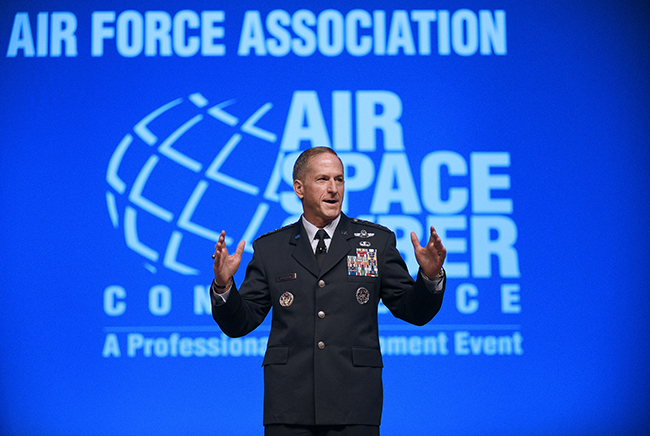
Air Force Chief of Staff Gen. David Goldfein delivers a keynote address during AFA's 2019 Air, Space & Cyber Conference in National Harbor, Md., near Washington, D.C. Staff photo by Mike Tsukamoto.
The Air Force is looking at multiple steps to help address an ongoing epidemic of suicide in its ranks, using feedback gathered from recent daylong pauses on operations across the service. Chief of Staff Gen. David Goldfein wants those conversations to mark the beginning of a wider effort to improve personal resiliency.
Nearly 80 airmen had killed themselves in 2019 as of the end of July, when Air Force leaders ordered wings to take a day to discuss the issue. That number rose to 100 airmen as of Sept. 21, meaning self-inflicted deaths have continued at about the same pace over the past two months.
“We’ve got to figure out why, and then we’ve got to make sure that we build the environment out there where the right thing is easy and the wrong thing is hard and unacceptable,” Goldfein told Air Force Magazine in an interview.
In a July 31 letter to commanders, Goldfein wrote that suicide is an “adversary that is killing more of our airmen than any enemy on the planet.” He left it up to local wings and squadrons on how to specifically handle discussions with their own airmen.
Late last week, Goldfein met with wing commanders to hear how the stand-downs went and the lessons leaders learned.
“I could not be prouder of the wing commanders and how they grabbed this,” Goldfein said. “The feedback I got as I listened to the kind of conversations they had, the things they did—they did exactly what I asked them to do.”
The most effective discussions took place when commanders shared their own stories, and their vulnerability spurred honest conversations. They “had to bring down barriers,” Goldfein said.
The process also harnessed the power of social media: a Facebook page called “AF Wingman Outreach” that encourages airmen to discuss their struggles has accumulated more than 31,000 members.
“The admins and moderators are not mental health experts,” the group’s description said. “We are trying to open a means of communication that has never existed before in the hopes that it will reduce the number of suicides in the Air Force.”
The Air Force is looking at implementing certain changes as a result of discussions within the service and feedback from the stand-down. While Goldfein doesn’t plan to force a large-scale program on the service or change regulations to address the problem, he said he hopes to find a balance between “the art and the science.”
Dorms, and the solitude some airmen experience in them, are one focus. The environment can become too private, Goldfein said, and airmen are left alone instead of spending time with others in their dorm. Commanders are considering ways to increase interactions between first-line supervisors, who spend the most time with airmen in dorms, and the residents. That can provide supervisors a better sense of whether “something doesn’t feel right,” Goldfein said.
Another idea gaining traction across the service is broadening the Task Force True North effort to reach more bases. This initiative, based on US Special Operations Command’s “Preservation of the Force and the Family,” treats human health like aircraft maintenance.
For example, there is a set schedule for bringing planes in for inspections where they pull panels and wires and check the health of the plane. In-depth depot maintenance happens later.
Following that model, airmen visit mental health professionals, chaplains, and counselors on their own set schedule. The goal is to avoid the stigma of coming forward for help.
“It becomes part of your duty. Everyone goes,” Goldfein said.
In AFSOC, the command is finding that airmen are remaining “Code One,” or fully healthy, longer. If someone does experience trauma, they recover more quickly than before the program was implemented. Seven bases in addition to AFSOC locations currently use the initiative, and Vice Chief of Staff Gen. Stephen Wilson is leading the effort to spread it to others.
The Air Force wants to ensure it is using all its possible resources to keep people in the military while they work through a hard time, not make them feel like they are being pushed out.
The service already sees what Goldfein calls “broken toy syndrome” in personnel with traumatic brain injuries, which can lead to other emotional issues like depression. If an airman takes a long time to decide to come forward for help, the consequences could feel like the Air Force is removing the reasons why they want to serve.
From that airman’s perspective, Goldfein said, “You took me away from my unit, which is my support system, and assigned me to another unit. You took away my special duty clearances, so I no longer get special duty pay for dive, jump clearances so now I’m being hurt financially as a result of coming forward.”
The Air Force is reversing its earlier actions so service members don’t feel left behind.
“The last thing we want to do is to immediately start taking away pay and benefits because that hurts not only the member, but also the family, so we instituted procedures so that now special duty pay stays on track,” Goldfein said. “The second step is, we don’t take you out of your unit.”
The four-star urges other service leaders to think of local steps they could take to change the stigma of coming forward about personal problems and of talking about suicide.
“This can’t be one-and-done, this can’t be the end of the campaign,” he said. “It’s actually the kickoff.”
The Veterans Crisis Hotline is available 24 hours a day, seven days a week, for veterans, service members, and their family and friends who need help. Call 800-273-8255 and press 1, text 838255, or visit www.veteranscrisisline.net.